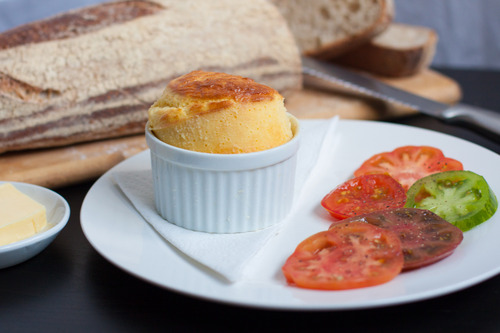Bill's cheese souffle with tomato salad
 Tuesday, January 10, 2017 at 9:06PM
Tuesday, January 10, 2017 at 9:06PM 
This recipe is from Bill Oglethorpe, trader at Borough Market and owner of Kappacasein Dairy. It first appeared on the Borough Market website as part of my series, I Am What I Eat, where I interview Borough Market traders about the foods that are important to them and why. This dish was one that his father used to make for the family when Bill was growing up in Zambia.
“My father used to make a soufflé and that’s an incredible transformation,” says Bill Oglethorpe of Kappacasein Dairy. “It’s quite magical to see it rise in the oven. It was a special event.” Did his father used to make it for special occasions? “No, I mean it was an occasion because the soufflé made it special.”
This was my first time making soufflé – despite being a competent cook I have always been terrified at the prospect. It turns out there’s no need to be; if you follow the instructions carefully it will work just fine. However, timing is everything – a hot soufflé will last at most 5 minutes out of the oven, so have your plates, sides and guests ready.
Bill’s father made a cheese soufflé with a béchamel base and a little Dijon mustard. He always served it with fresh tomatoes, crusty bread and butter.
Makes 8 individual soufflés or one large soufflé.

Ingredients
For the tomato salad:
1 small garlic clove
Pinch rock salt
1 tsp Dijon
½ tsp red or sherry vinegar
60ml olive oil
500g fresh tomatoes, sliced or diced
For the souffle
40g butter, plus extra for greasing
40g plain flour
200ml whole milk
100g cheddar cheese, grated
2 tsp Dijon mustard
4 eggs (room temperature), separated
50g Parmesan
Method
For the tomato salad
To make the dressing, crush the garlic with rock salt using a fork to mash it. Add to a small bowl with the Dijon mustard and vinegar. Slowly whisk in the olive oil to form an emulsified dressing. Just before serving, whisk again and toss with the tomatoes.
For the souffle
Preheat the oven to 220C. Butter 8 individual ramekins or 1 large soufflé dish and place in the fridge.
Melt the butter in a saucepan over a low heat. Add the flour and whisk it in. Cook for a few minutes, whisking frequently. Slowly add the milk, whisking constantly. Allow it to thicken a little, then add the cheese and whisk until melted.
Remove the béchamel from the heat, allow to cool slightly then whisk in the egg yolks and Dijon. Season with salt and freshly ground pepper, to taste.
Remove the soufflé moulds from the fridge and butter again with melted butter, then coat with Parmesan.
Beat the egg whites until they form stiff peaks. Make sure the béchamel is still a little warm (if not, gently warm it). Whisk a small amount of the egg whites into the béchamel to slacken it. Gently fold in the rest of the mixture until just incorporated. Pour the mixture into the mould(s) until they are about ¾ full.
If cooking individual soufflés, cook them at 220C for 2 minutes, then reduce the temperature to 200C and cook for a further 10 minutes. If cooking one large soufflé cook for 5 minutes at 220C, then reduce the temperature to 200C and cook for a further 25 minutes. Never open the oven or the soufflé(s) will not rise.
Serve immediately with tomato salad, fresh bread and butter.

Here's a few more tips for getting your souffle right, if you need them. You can read my interview with Bill here or on the Borough Market website.
 Vix |
Vix |  Post a Comment |
Post a Comment | 
Reader Comments